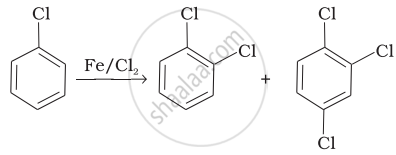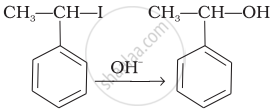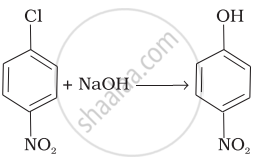Advertisements
Advertisements
प्रश्न
The treatment of alkyl chlorides with aqueous KOH leads to the formation of alcohols but in the presence of alcoholic KOH, alkenes are major products. Explain.
उत्तर १
In an aqueous solution, KOH almost completely ionizes to give OH– ion, a strong nucleophile and reacts with alkyl halides to form alcohols. In an aqueous solution, OH– ions are highly hydrated. This reduces the basic character of OH– ions, due to which they fail to separate hydrogen atoms from the β-carbon of alkyl halide and cannot form an alkene.
On the other hand, alcoholic solution of KOH contains alkoxide (RO–) ions which, being a stronger base than OH–, easily remove HCl molecule from alkyl chloride to form alkene.
उत्तर २
Simple nucleophilic substitution occurs when alkyl chlorides react with aqueous KOH to form alcohols.
\[\ce{CH3 - CH2 - Cl + KOH ->[H2O]CH3 - CH2 - OH + KCl}\]
When aqueous KOH is substituted with alcoholic KOH, HCI is eliminated from an alkyl halide, resulting in the formation of alkenes instead of alcohols.
\[\ce{CH3 - CH2Cl + KOH->[EtOH] CH2 = CH2}\]
This can be explained by the size of the nucleophile in both reactions. In an aqueous medium, the \[\ce{N\overset{Θ}{u}}\] is \[\ce{\overset{Θ}{O}H}\] which is small, whereas in an alcoholic medium, the \[\ce{N\overset{Θ}{u}}\] is \[\ce{C2H^Θ5}\] is bulky.
The bulky \[\ce{N\overset{Θ}{u}}\] always find it easier to abstract a proton rather than attack a tetravalent carbon and form a substitution product.

If C2H5OΘ attacks a carbon-carrying halogen, steric repulsions can delay the attack and prevent substitution.
Notes
Students can refer to the provided solutions based on their preferred marks.
APPEARS IN
संबंधित प्रश्न
Write the main products when methyl chloride is treated with AgCN.
Given reasons: C–Cl bond length in chlorobenzene is shorter than C–Cl bond length in CH3–Cl.
In the following pair of halogen compounds, which compound undergoes a faster SN1 reaction?

Write the structure of the major organic product in the following reaction:
\[\ce{CH3CH2Br + KCN ->[aq.ethanol]}\]
How the following conversion can be carried out?
Ethyl chloride to propanoic acid
SN1 reactions are accompanied by racemization in optically active alkyl halides.
Given reasons: SN1 reactions are accompanied by racemization in optically active alkyl halides.
In a coordination entity of the type [PtCl2(en)2]2+ which isomer will show optical isomerism?
Which of the following is an example of SN2 reaction?
Which one is most reactive towards SN1 reaction?
Which of the following compounds is optically active?
Racemic compound has ____________.
Read the passage given below and answer the following question:
Nucleophilic substitution reaction of haloalkane can be conducted according to both SN1 and SN2 mechanisms. However, which mechanism it is based on is related to such factors as the structure of haloalkane, and properties of leaving group, nucleophilic reagent and solvent.
Influences of halogen: No matter which mechanism the nucleophilic substitution reaction is based on, the leaving group always leave the central carbon atom with electron pair. This is just the opposite of the situation that nucleophilic reagent attacks the central carbon atom with electron pair. Therefore, the weaker the alkalinity of leaving group is, the more stable the anion formed is and it will be more easier for the leaving group to leave the central carbon atom; that is to say, the reactant is more easier to be substituted. The alkalinity order of halogen ion is I− < Br− < Cl− < F− and the order of their leaving tendency should be I− > Br− > Cl− > F−. Therefore, in four halides with the same alkyl and different halogens, the order of substitution reaction rate is RI > RBr > RCl > RF. In addition, if the leaving group is very easy to leave, many carbocation intermediates are generated in the reaction and the reaction is based on SN1 mechanism. If the leaving group is not easy to leave, the reaction is based on SN2 a mechanism.
Influences of solvent polarity: In SN1 reaction, the polarity of the system increases from the reactant to the transition state, because polar solvent has a greater stabilizing effect on the transition state than the reactant, thereby reduce activation energy and accelerate the reaction. In SN2 reaction, the polarity of the system generally does not change from the reactant to the transition state and only charge dispersion occurs. At this time, polar solvent has a great stabilizing effect on Nu than the transition state, thereby increasing activation energy and slow down the reaction rate. For example, the decomposition rate (SN1) of tertiary chlorobutane in 25℃ water (dielectric constant 79) is 300000 times faster than in ethanol (dielectric constant 24). The reaction rate (SN2) of 2-bromopropane and NaOH in ethanol containing 40% water is twice slower than in absolute ethanol. In a word, the level of solvent polarity has influence on both SN1 and SN2 reactions, but with different results. Generally speaking, weak polar solvent is favorable for SN2 reaction, while strong polar solvent is favorable for SN1 reaction, because only under the action of polar solvent can halogenated hydrocarbon dissociate into carbocation and halogen ion and solvents with a strong polarity is favorable for solvation of carbocation, increasing its stability. Generally speaking, the substitution reaction of tertiary haloalkane is based on SN1 mechanism in solvents with a strong polarity (for example, ethanol containing water).
SN1 mechanism is favoured in which of the following solvents:
Write the structures and names of the compounds formed when compound ‘A’ with molecular formula, \[\ce{C7H8}\] is treated with \[\ce{Cl2}\] in the presence of \[\ce{FeCl3}\].
Elimination reactions (especially β-elimination) are as common as the nucleophilic substitution reaction in case of alkyl halides. Specify the reagents used in both cases.
Cyanide ion acts as an ambident nucleophile. From which end it acts as a stronger nucleophile in aqueous medium? Give reason for your answer.
Match the reactions given in Column I with the types of reactions given in Column II.
| Column I | Column II | |
| (i) |  |
(a) Nucleophilic aromatic substitution |
| (ii) | \[\begin{array}{cc} \ce{CH3 - CH = CH2 + HBr -> CH3 - CH - CH3}\\ \phantom{............................}|\phantom{}\\ \phantom{.............................}\ce{Br}\phantom{} \end{array}\] |
(b) Electrophilic aromatic substitution |
| (iii) |  |
(c) Saytzeff elimination |
| (iv) |  |
(d) Electrophilic addition |
| (v) | \[\begin{array}{cc} \ce{CH3 CH2 CH CH3 ->[alc.KOH] CH3 CH = CH CH3}\\ \phantom{}|\phantom{..........................}\\ \phantom{}\ce{Br}\phantom{........................} \end{array}\] |
(e) Nucleophilic substitution (SN1) |
Discuss the mechanism of alkaline hydrolysis of methyl bromide.
Which alkyl halide from the following pair would you expect to react more rapidly by an SN2 mechanism? Explain your answer.
\[\begin{array}{cc}\ce{CH3CH2CHCH3}\\\phantom{...}|\\\phantom{....}\ce{Br}\end{array}\] or \[\begin{array}{cc}\phantom{.....}\ce{CH3}\\\phantom{..}|\\\ce{H3C - C - Br}\\\phantom{..}|\\\phantom{....}\ce{CH3}\end{array}\]
